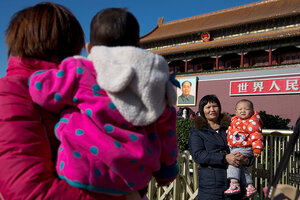China urged to drop one-child policy. But will young couples opt for two?
Last year, Beijing had expected two million extra babies after loosening its longstanding one-child limit per couple. But only 700,000 more babies were delivered.

Women cuddle their child at Tiananmen Gate in Beijing, Nov. 16, 2013. Despite earlier estimates that new exemptions to China's one-child policy would add up to 2 million extra births per year, only 700,000 newly qualified couples applied to have a second child this year, a Chinese official said.
Andy Wong/AP/File
Beijing
The Chinese government’s top think tank on social policy has urged Beijing to drop its controversial one child policy, saying it has outlived its usefulness and now threatens dire consequences.
After more than 30 years of strict birth control, China is coming dangerously close to a “low fertility trap” in which birthrates would go into an uncontrollable downward spiral, according to a report Monday by the Chinese Academy for Social Sciences (CASS).
The danger of China’s low birthrate is twofold, says Qiao Xiaochun, a demographer at Peking University. “Chinese society is aging rapidly, and there is a lack of social support for the elderly,” he points out.
By 2050, China will have 480 million people over the age of 60 – a quarter of the world’s elderly population – according to a report earlier this year by the China National Commission on Aging.
At the same time, Prof. Qiao warns, “there will be shortages in the labor force.” And unless the government can reverse the falling birthrate trend, serious problems lie ahead.
The government says the one child policy, formally introduced in 1980, has helped avert 400 million births and played a key role in making China a more prosperous country. But for the past four years, the CASS report finds, the “demographic dividend” has been falling and the policy’s negative effects have become more obvious.
China, with a population of 1.4 billion, is now just past a tipping point: Its workforce began to shrink in 2012 and will continue to do so for the foreseeable future. Its current birthrate, estimated at 1.4, is well below the replacement rate of 2.1 and lower even than Europe's, which has an average fertility rate of 1.6.
“The one child policy should be changed and everybody should be allowed to have two children,” argues Qiao. But even if the government followed that advice and the CASS recommendations today, “it is kind of late” to turn things around, he worries.
These days, young urban Chinese couples are less keen on having more than one child, even when they are allowed to. Frightened by the spiraling cost of raising and educating a child, and of buying an apartment big enough for a family of four, many are voluntarily sticking with one baby.
Last year, the government tinkered with its once-draconian policy, allowing couples to have two children if one of them is an only child him or herself. The result has been underwhelming. The Family Planning Commission had predicted two million extra babies would be born this year. In fact, only 700,000 have been born.
“China’s low fertility level is a result of the country’s economic and social development, not of family planning policy,” says Liang Zhongtang, a member of the National Family Planning Commission. “Changing the policy would not make much difference.”

